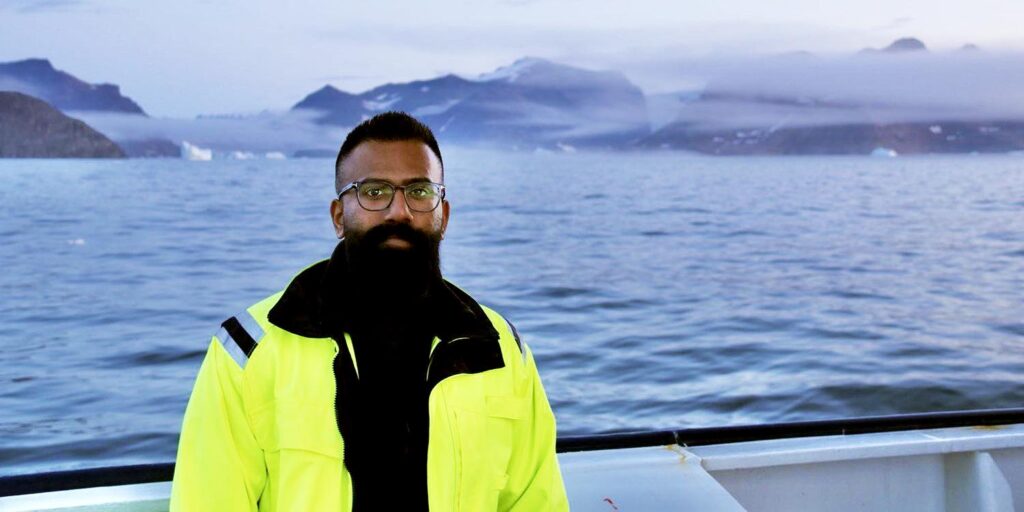
Endured. Many people suffer from the monotony of longer sailing trips. But that didn’t stop Tarun Kadri Sathyian, a doctoral student at Chalmers and affiliated with C2B2, from losing his courage when he went on a nine-day trip to Greenland with the R/V Skagerak in August. – A fantastic experience, he says.
In early August, when summer was still in full swing, Tarun Kadri Sathiyan, a doctoral student at Chalmers and affiliated with C2B2, packed his winter clothes and boarded the research vessel R/V Skagerak. It was time for a nine-day journey, bordered by ice and cold, with destination Greenland.
– The vast size and silence of the Arctic made a deep impression on me, he says.
Tarun Kadri Sathiyan, originally from Bangalore in India, came to Sweden five years ago. After a bachelor’s degree in mechanical engineering from Reva University in Bangalore, he had been accepted as a master’s student at Chalmers University of Technology, specializing in automotive engineering.
After his master’s studies were completed in 2022, he worked as a research assistant for a couple of years. In 2024, he began doctoral studies at the Department of Mechanics and Maritime Sciences at Chalmers. A work that, among other things, aims to develop autonomous underwater robots and measurement techniques for oceanographic monitoring and data collection, with a focus on challenging and unpredictable marine environments. That work in turn brought him into C2B2’s research on open, data-driven innovation and new technology.
When the research vessel R/V Skagerak this spring announced the opportunity for young researchers (early-career research program) to go to Greenland, it was a good match. It clicked with several of Tarun’s areas of interest around measurements, data and the harsh marine environment. But he was not the only one interested, the program received over a hundred applicants for five places, and his hopes were quite low.
– I was very surprised when I found out that I had been accepted. It felt fantastic.
So, on August 10, when most people at home were still walking around in shorts, he climbed the steps of the R/V Skagerak with his bag packed with winter clothes. The ship set off from the port of Reykjavík, with the destination set for the fjords in the southeastern part of Greenland.
– The reason I wanted to go was to gain first-hand experience of fieldwork in the polar regions, to better understand the challenges, he says.
The stay itself, with a number of people living together in a limited space, was easy for him to adapt to.
– It was exciting to see how quickly we became a community.
They shared knowledge and supported each other during the long working days, with weather, wind and ice that were tough and unpredictable.
One occasion that has been etched in his memory was when they were going to lay out a mooring near the Greenland fjords, in difficult conditions. Fog, ice and a ship rocking in heavy swells.
– Icebergs were floating all around us. Some stood on the bridge with the captain and warned when the ice got too close, while others stood on deck and worked with the winches while making sure that the ropes for the scientific equipment did not get caught in the rough ice floating around.
The work required total focus, close cooperation and complete trust in each other.
– How it felt? Both challenging and exciting, I would say. It gave me an idea of the skill and coordination required to conduct research in such a harsh environment.
Before he went, he had done research about the logistical and technical challenges of Arctic waters, with rapidly changing conditions, lack of time and high demands on precision when handling instruments. But experiencing it firsthand was a completely different matter. But discouraged? No, not at all, he says.
– Rather, it strengthened my motivation to continue working on this, and in my belief that technology can make a difference.
On board, he worked closely with researchers from a range of disciplines – oceanographers, glaciologists, climate scientists and engineers. A great experience says Tarun Kadri Sathiyan.
– Research is definitely richer when different perspectives meet, when you get to learn about methods and questions that are outside your own expertise.
One of his strongest memories from the trip was when he saw the Greenland fjords from the deck for the very first time.
– Just standing there and looking at the enormous landscape was astonishing. The area is important from a research point of view, and also very vulnerable due to climate change.
How was the weather during the trip?
– Quite variable. Often icy, foggy and barren out at sea, other times quite calm.
Did you see any exciting animal species?
– We saw a lot of whales. Also, seals and various bird species. But unfortunately, no polar bears.
What measuring instruments did you have with you?
– The ship was well equipped with sensors, laboratories and other measuring instruments that we used to collect various data. So, I didn’t have to bring any of my own.
Other researchers have told similar stories about amazing nature experiences, but also about the monotony of long voyages. What´s your view on that?
– It was mostly exciting and interesting. Sure, also a lot of routine and such. But, no, I didn’t suffer from it. I would gladly go again if I had the chance.
Facts: Tarun Kadri Sathiyan
Age: 28 years old.
Lives: Gothenburg.
Interests: Robotics, vehicles, technology, writing, reading, music and strength training.
Listens to: Metallica, ABBA, Backstreet Boys and many more. “I’ve recently started to get interested in Swedish music, like Kent and Håkan Hellström.”
Reads: Agatha Christie, Haruki Murakami and others.
Drives: Mostly utilizes public transport, “but I like to ride a motorcycle.”